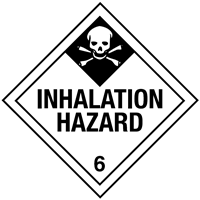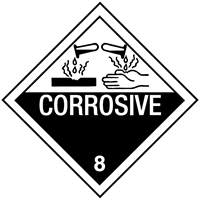
 Print
Print
Chemical Datasheet
SULFURYL CHLORIDE |


|
Chemical Identifiers
| CAS Number |
UN/NA Number |
DOT Hazard Label |
USCG CHRIS Code |
- 7791-25-5

|
|
- Poison Inhalation Hazard
- Corrosive
|
|
| NIOSH Pocket Guide |
International Chem Safety Card |
|
none
|
|
NFPA 704
General Description
A colorless fuming liquid with a pungent odor. Very toxic by inhalation. Corrosive to metals and tissue.
Hazards
Reactivity Alerts
- Water-Reactive
- Air-Reactive
Air & Water Reactions
Fumes in air. Reacts with moist air to give strongly acidic mists that are heavier than air. Decomposes slowly in water to give hydrochloric acid and sulfuric acid [Handling Chemicals Safely p. 881 1980].
Based on a scenario where the chemical is spilled into an excess of water (at least 5 fold excess of water), half of the maximum theoretical yield of Hydrogen Chloride gas will be created in 8.7 minutes. Experimental details are in the following: "Development of the Table of Initial Isolation and Protective Distances for the 2008 Emergency Response Guidebook", ANL/DIS-09-2, D.F. Brown, H.M. Hartmann, W.A. Freeman, and W.D. Haney, Argonne National Laboratory, Argonne, Illinois, June 2009.
Fire Hazard
Behavior in Fire: Toxic and irritating gases are generated. (USCG, 1999)
Health Hazard
Vapors cause severe irritation of eyes and respiratory system. Liquid burns eyes and skin. If ingested, can cause severe burns of mouth and stomach. (USCG, 1999)
Reactivity Profile
SULFURYL CHLORIDE reacts exothermically with water. Incompatible with strong oxidizing agents, alcohols, amines. Reacts violently with bases. Attacks many metals. Can react explosively with lead dioxide [Mellor 10:676 1946-47]. May react vigorously or explosively if mixed with diisopropyl ether or other ethers in the presence of trace amounts of metal salts [J. Haz. Mat., 1981, 4, 291].
Belongs to the Following Reactive Group(s)
- Acyl Halides, Sulfonyl Halides, and Chloroformates
Potentially Incompatible Absorbents
Use caution: Liquids with this reactive group classification have been
known to react with the
absorbents
listed below.
- Cellulose-Based Absorbents
- Mineral-Based & Clay-Based Absorbents
- Dirt/Earth
Response Recommendations
Isolation and Evacuation
Excerpt from ERG Guide 137 [Substances - Water-Reactive - Corrosive]:
IMMEDIATE PRECAUTIONARY MEASURE: Isolate spill or leak area in all directions for at least 50 meters (150 feet) for liquids and at least 25 meters (75 feet) for solids.
SPILL: See ERG Table 1 - Initial Isolation and Protective Action Distances on the UN/NA 1834 datasheet.
FIRE: If tank, rail tank car or highway tank is involved in a fire, ISOLATE for 800 meters (1/2 mile) in all directions; also, consider initial evacuation for 800 meters (1/2 mile) in all directions. (ERG, 2024)
Firefighting
Excerpt from ERG Guide 137 [Substances - Water-Reactive - Corrosive]:
When material is not involved in fire, do not use water on material itself.
SMALL FIRE: Dry chemical or CO2. If it can be done safely, move undamaged containers away from the area around the fire.
LARGE FIRE: Flood fire area with large quantities of water, while knocking down vapors with water fog. If insufficient water supply, responders should withdraw.
FIRE INVOLVING TANKS, RAIL TANK CARS OR HIGHWAY TANKS: Cool containers with flooding quantities of water until well after fire is out. Do not get water inside containers. Withdraw immediately in case of rising sound from venting safety devices or discoloration of tank. ALWAYS stay away from tanks in direct contact with flames. (ERG, 2024)
Non-Fire Response
Excerpt from ERG Guide 137 [Substances - Water-Reactive - Corrosive]:
Do not touch damaged containers or spilled material unless wearing appropriate protective clothing. Stop leak if you can do it without risk. Use water spray to reduce vapors; do not put water directly on leak, spill area or inside container. Keep combustibles (wood, paper, oil, etc.) away from spilled material.
SMALL SPILL: Cover with DRY earth, DRY sand or other non-combustible material followed with plastic sheet to minimize spreading or contact with rain. Use clean, non-sparking tools to collect material and place it into loosely covered plastic containers for later disposal. Prevent entry into waterways, sewers, basements or confined areas. (ERG, 2024)
Protective Clothing
Chemical goggles and face shield; mask with acid-type canister; rubber gloves and boots. (USCG, 1999)
DuPont Tychem® Suit Fabrics
Normalized Breakthrough Times (in Minutes)
| Chemical |
CAS Number |
State |
QS |
QC |
SL |
C3 |
TF |
TP |
RC |
TK |
RF |
| Sulfuryl chloride |
7791-25-5 |
Liquid |
|
|
|
120 |
>480 |
>480 |
>480 |
>480 |
>480 |
Special Warning from DuPont: Tychem® and Tyvek® fabrics should not be
used around heat, flames, sparks or in potentially flammable or
explosive environments. Only...
(DuPont, 2024)
First Aid
Call a doctor.
INHALATION: remove to fresh air; administer artificial respiration if required.
INGESTION: give water or milk; do NOT induce vomiting.
EYES: flush with water for at least 15 min.
SKIN: wash with large amounts of water. (USCG, 1999)
Physical Properties
Flash Point: data unavailable
Lower Explosive Limit (LEL): data unavailable
Upper Explosive Limit (UEL): data unavailable
Autoignition Temperature:
Not flammable
(USCG, 1999)
Melting Point: data unavailable
Vapor Pressure: data unavailable
Vapor Density (Relative to Air): data unavailable
Specific Gravity:
1.67
at 68°F
(USCG, 1999)
- Denser than water; will sink
Boiling Point:
156.4°F
at 760 mmHg
(USCG, 1999)
Molecular Weight:
134.97
(USCG, 1999)
Water Solubility: data unavailable
Ionization Energy/Potential: data unavailable
IDLH: data unavailable
AEGLs (Acute Exposure Guideline Levels)
Final AEGLs for Sulfuryl chloride (7791-25-5)
| Exposure Period |
AEGL-1 |
AEGL-2 |
AEGL-3 |
| 10 minutes |
NR |
4.7 ppm |
14 ppm |
| 30 minutes |
NR |
4.7 ppm |
14 ppm |
| 60 minutes |
NR |
3.7 ppm |
11 ppm |
| 4 hours |
NR |
2.3 ppm |
7 ppm |
| 8 hours |
NR |
1.2 ppm |
3.5 ppm |
(NAC/NRC, 2024)
ERPGs (Emergency Response Planning Guidelines)
| Chemical |
ERPG-1 |
ERPG-2 |
ERPG-3 |
| Sulfuryl Chloride (7791-25-5)
|
0.3 ppm  |
3 ppm |
15 ppm |
(AIHA, 2022)
PACs (Protective Action Criteria)
| Chemical |
PAC-1 |
PAC-2 |
PAC-3 |
| Sulfuryl chloride (7791-25-5)
|
0.3 ppm |
3.7 ppm |
11 ppm |
(DOE, 2024)
Regulatory Information
EPA Consolidated List of Lists
No regulatory information available.
CISA Chemical Facility Anti-Terrorism Standards (CFATS)
|
RELEASE |
THEFT |
SABOTAGE |
| Chemical of Interest |
CAS Number |
Min Conc |
STQ |
Security
Issue |
Min Conc |
STQ |
Security
Issue |
Min Conc |
STQ |
Security
Issue |
| Sulfuryl chloride |
7791-25-5 |
|
|
|
|
|
|
ACG |
APA |
sabotage/ contamination |
(CISA, 2007)
OSHA Process Safety Management (PSM) Standard List
No regulatory information available.
Alternate Chemical Names
- SULFONYL CHLORIDE
- SULFONYL DICHLORIDE
- SULFUR CHLORIDE OXIDE (SCL2O2)
- SULFUR CHLORIDE OXIDE (SO2CL2)
- SULFUR OXYCHLORIDE (SO2CL2)
- SULFURIC DICHLORIDE
- SULFURIC OXYCHLORIDE
- SULFURYL CHLORIDE
- SULFURYL CHLORIDE (SO2CL2)
- SULFURYL DICHLORIDE
- SULPHURYL CHLORIDE



 Print
Print

